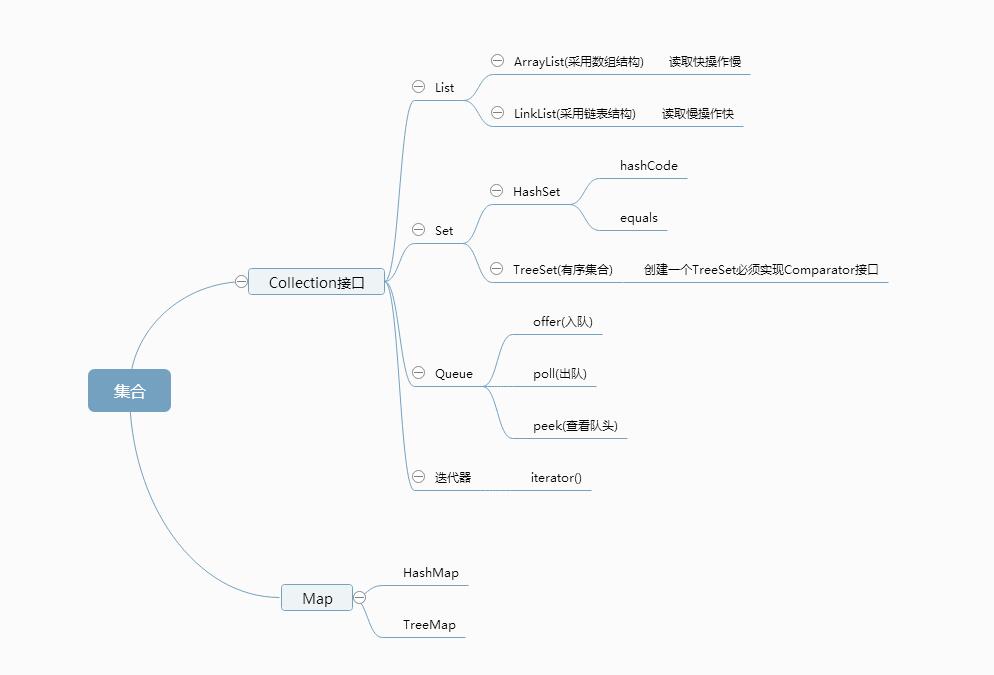201521123113《Java程序设计》第7周学习总结
1. 本周学习总结

2. 书面作业
Q1.ArrayList代码分析
1.1 解释ArrayList的contains源代码
contains源代码:
public boolean contains(Object o) {
return indexOf(o) >= 0;
}
public int indexOf(Object o) {
if (o == null) {
for (int i = 0; i < size; i++)
if (elementData[i]==null)
return i;
} else {
for (int i = 0; i < size; i++)
if (o.equals(elementData[i]))
return i;
}
return -1;
}
- 由contains源代码可见,比较时用到的是object。首先判断传入的object是否为空,否则无法调用equals方法。若o不为空,则遍历ArrayList用equals()方法比较返回一个boolean值。
1.2 解释E remove(int index)源代码
E remove(int index)源代码:
public E remove(int index) {
rangeCheck(index);
modCount++;
E oldValue = elementData(index);
int numMoved = size - index - 1;
if (numMoved > 0)
System.arraycopy(elementData, index+1, elementData, index,
numMoved);
elementData[--size] = null; // clear to let GC do its work
return oldValue;
}
private void rangeCheck(int index) {
if (index >= size)
throw new IndexOutOfBoundsException(outOfBoundsMsg(index));
}
- 首先 rangeCheck()判断index是否在范围内,如果没有则抛出IndexOutOfBoundsException异常;
- 然后,对数组进行删除,把index后面的数组往前移一位。
1.3 结合1.1与1.2,回答ArrayList存储数据时需要考虑元素的类型吗?
- ArrayList存储数据时不用考虑元素的类型,因为ArrayList用的是object类对象,而object类默认是所有类的父类,也就是说所有类型都可以用ArrayList。
1.4 分析add源代码,回答当内部数组容量不够时,怎么办?
- add源代码中,
ensureCapacityInternal(size + 1),当内部容量不够时,ArrayList就会增加容量,就是所谓的动态数组。
1.5 分析private void rangeCheck(int index)源代码,为什么该方法应该声明为private而不声明为public?
- 我觉得在ArrayList.class里的许多方法都用到了rangeCheck()方法,在外部调用仅需要调用这些方法,没必要再调用一次rangeCheck()方法。rangeCheck()方法类似非常底层的方法,用户没必要去调用他。
Q2.HashSet原理
2.1 将元素加入HashSet(散列集)中,其存储位置如何确定?需要调用那些方法?
- 散列表用链表数组实现,每个列表被称为桶。通过计算出待存储对象的散列码(hashCode),作为存储的位置,如果遇到冲突则用链表连接。
- 初始情况下调用hashCode()方法计算对象的哈希码;如果桶中已有其他元素,则调用equals()方法与已有元素进行比较。
Q3.ArrayListIntegerStack
3.1 比较自己写的ArrayListIntegerStack与自己在题集jmu-Java-04-面向对象2-进阶-多态、接口与内部类中的题目5-3自定义接口ArrayIntegerStack`,有什么不同?(不要出现大段代码)
- java06的ArrayListIntegerStack用的是ArraList来实现栈,java05的ArrayIntegerStack用的是数组来实现栈。
- 在java06的ArrayListIntegerStack中,不需要判断栈满,因为ArrayList是动态数组,会自动扩充容量;不需要用到top指针。
3.2 简单描述接口的好处.
- 一个类只能继承另一个类,而一个类可以接入多个接口;可以根据不同需求定义不同的方法;提高多人编程的效率。
Q4.Stack and Queue
4.1 编写函数判断一个给定字符串是否是回文,一定要使用栈,但不能使用java的Stack类(具体原因自己搜索)。请粘贴你的代码,类名为Main你的学号。
import java.util.*;
public class Main113 {
public static void main(String[] args) {
Scanner in = new Scanner(System.in);
while(in.hasNext()){
System.out.println(isPalindrome(in.nextLine()));
}
}
public static boolean isPalindrome(String str){
List<Character> stack = new ArrayList<Character>();
List<Character> stack2 = new ArrayList<Character>();
for(int i=0;i<str.length()/2;i++){
stack.add(str.charAt(i));
stack2.add(str.charAt(str.length()-i-1));
}
for(int i=str.length()/2-1;i>=0;i--){
if(stack.remove(i) != stack2.remove(i)){
return false;
}
}
return true;
}
}
结果

4.2 题集jmu-Java-05-集合之5-6 银行业务队列简单模拟。(不要出现大段代码)
import java.util.*;
public class Six {
public static void main(String[] args) {
Scanner in = new Scanner(System.in);
Queue<Integer> List1 = new LinkedList<Integer>();
Queue<Integer> List2 = new LinkedList<Integer>();
int n = in.nextInt();
for (int i = 0; i < n; i++) {
int x = in.nextInt();
if (x % 2 == 0) {
List1.offer(x);
}
else List2.offer(x);
}
while (!List1.isEmpty() || !List2.isEmpty()) {
if(!List2.isEmpty())
System.out.print(List2.poll()+" ");
if(!List2.isEmpty())
System.out.print(List2.poll()+" ");
if(!List1.isEmpty())
System.out.print(List1.poll()+" ");
}
}
}
Q5.统计文字中的单词数量并按单词的字母顺序排序后输出
import java.util.*;
public class two {
public static void main(String[] args) {
Scanner in=new Scanner(System.in);
TreeSet<String> str=new TreeSet<String>();
while(in.hasNext()){
String str1=in.next();
if(str1.equals("!!!!!"))
break;
str.add(str1);
}
System.out.println(str.size());
Object[] out = str.toArray();
if(str.size()<=10)
for (int i = 0; i < out.length; i++) {
System.out.println(out[i]);
}
else for (int j = 0; j < 10; j++) {
System.out.println(out[j]);
}
}
}
5.1 实验总结
- 用TreeSet可以实现对str内的元素进行排序,不需要再用别的方法;
- 用
Object[] out = str.toArray()这句可以把str内的元素转成Object数组,好格式化输出形式。
3. 码云上代码提交记录及PTA实验总结




